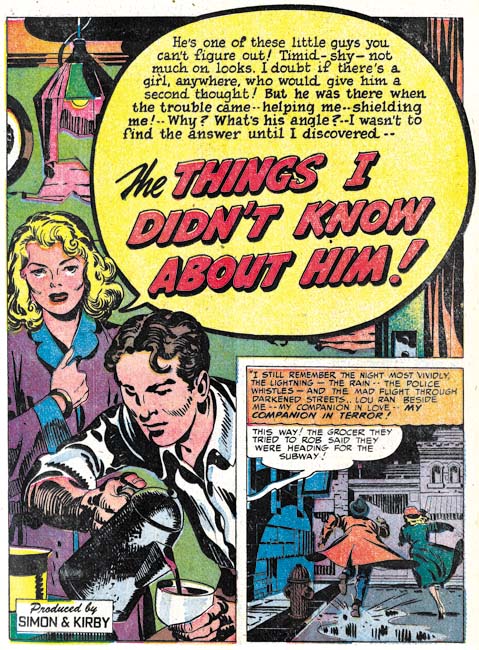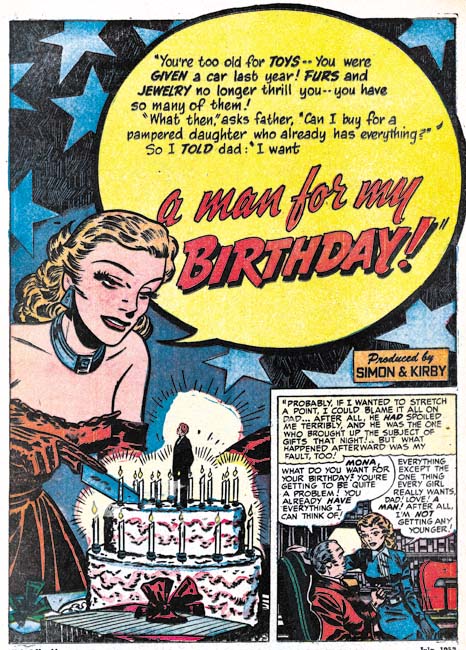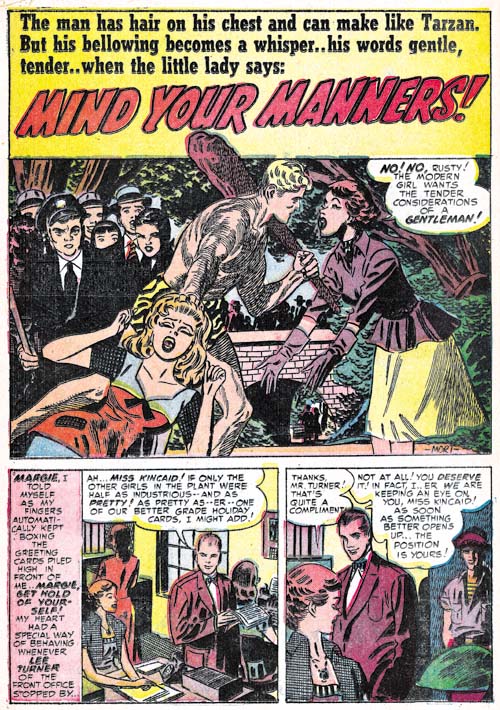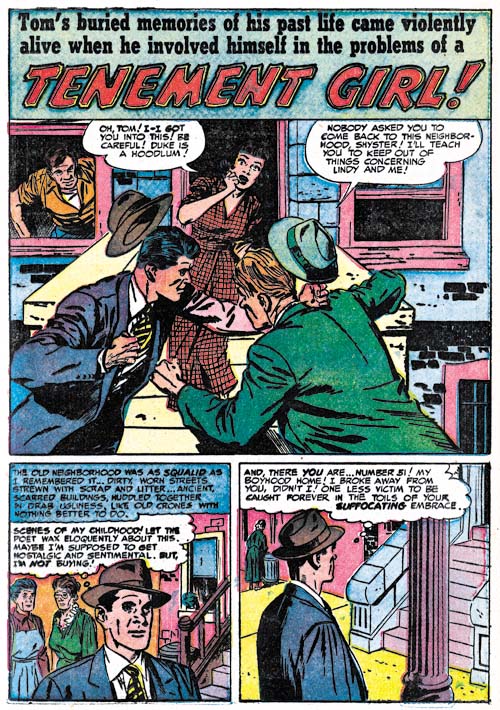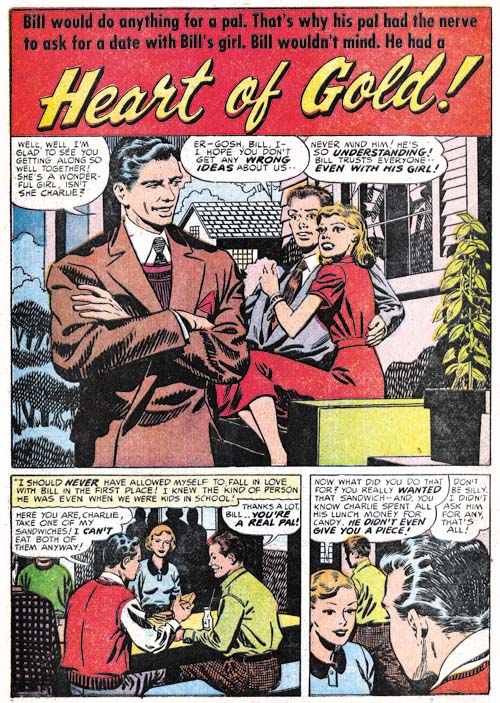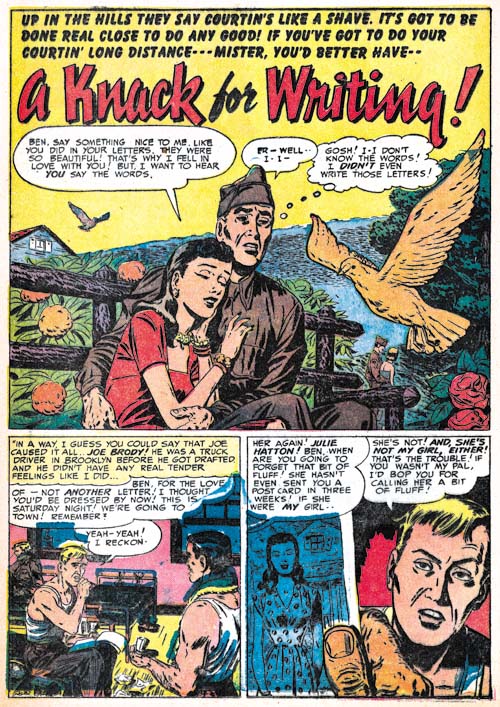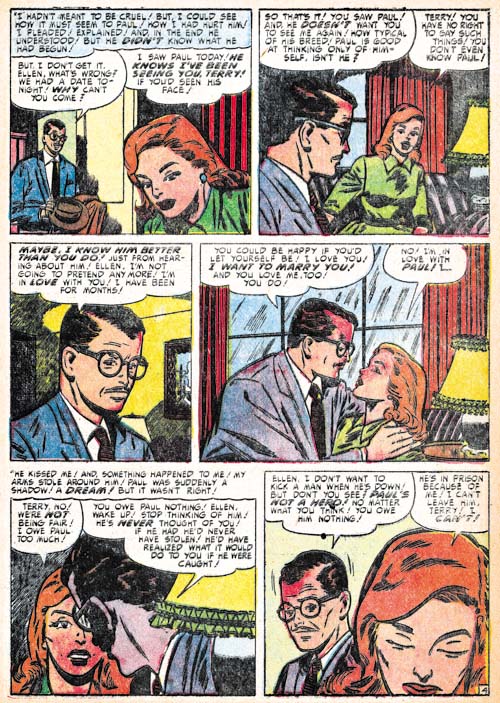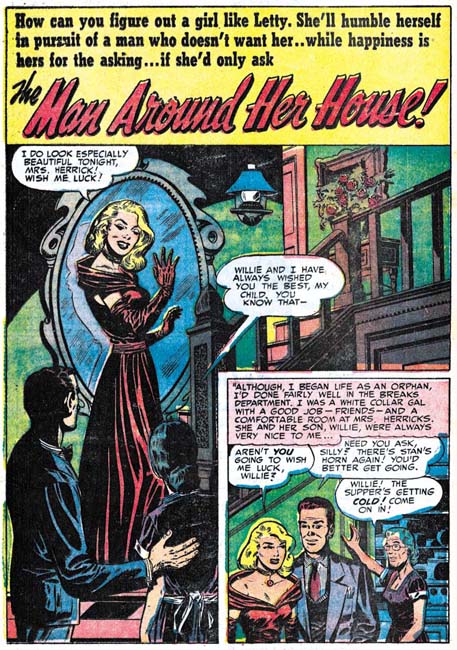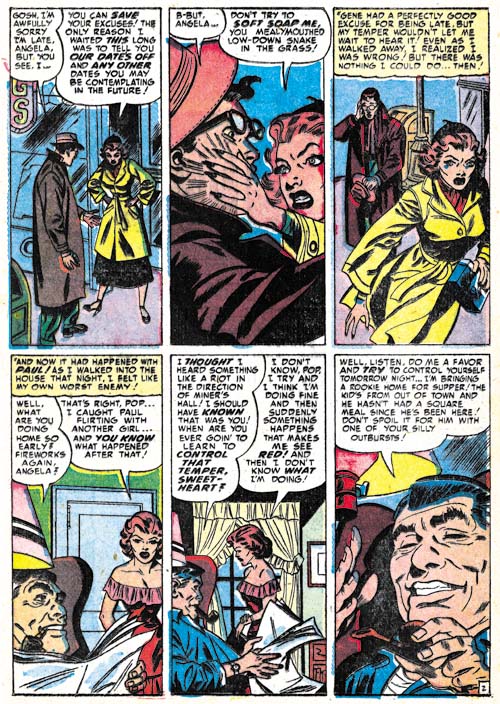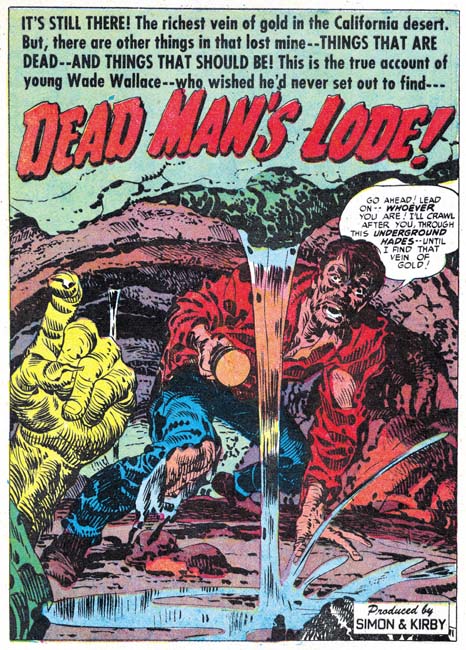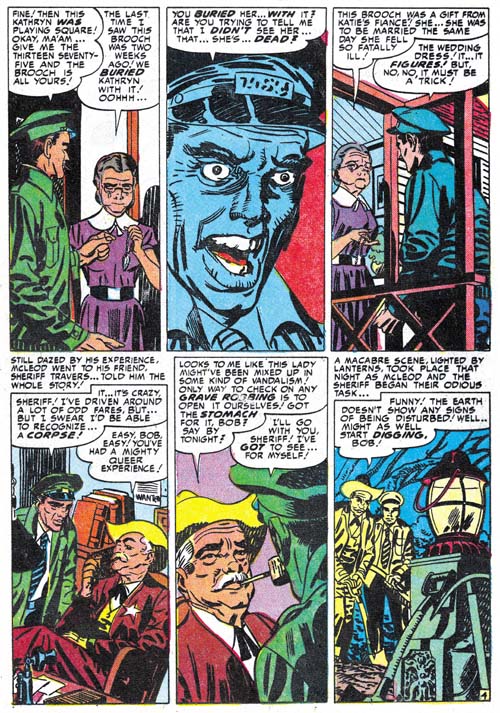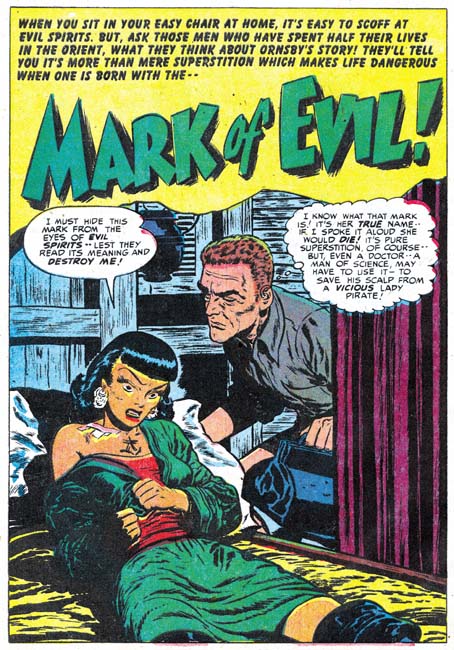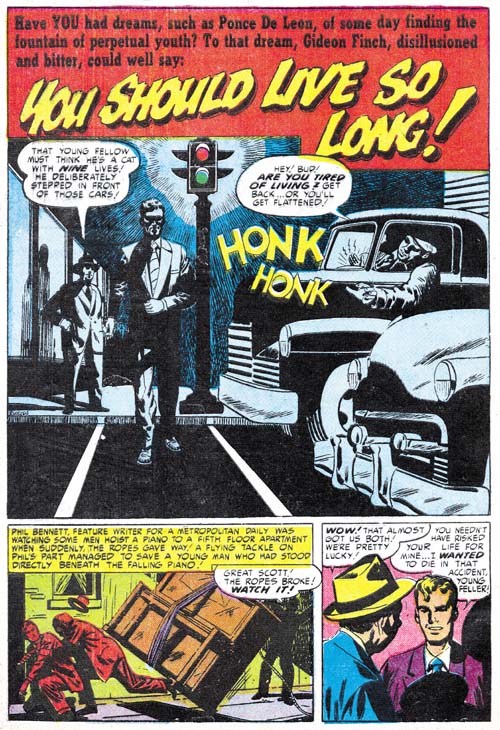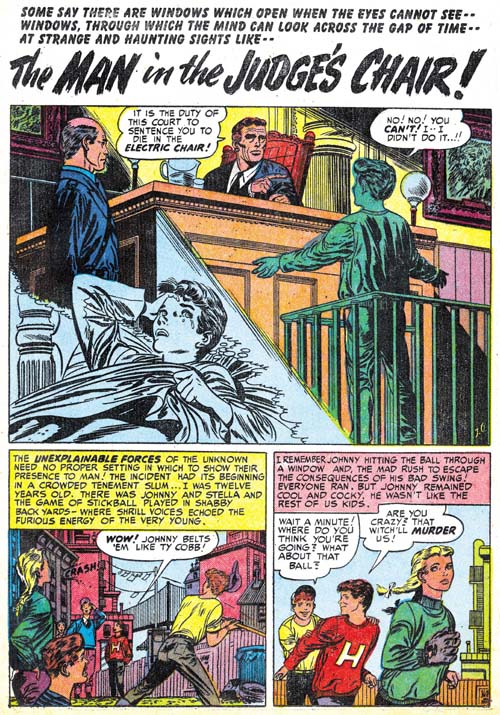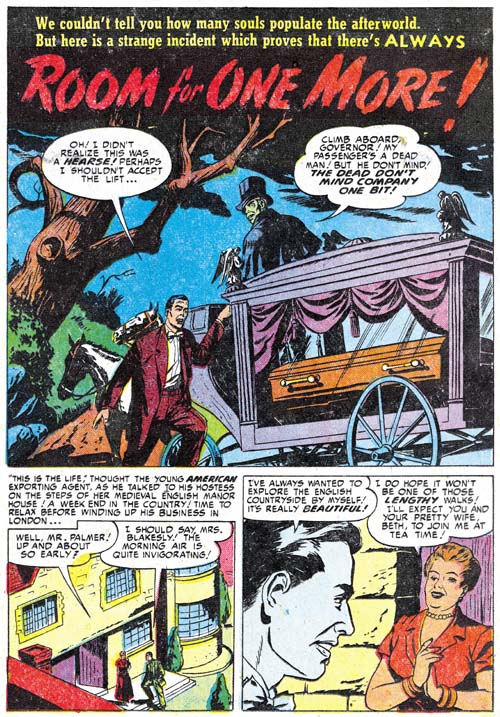(May 1953 – July 1953: Young Romance #57 – #59, Young Love #45 – #47, Young Brides #5 – #6)
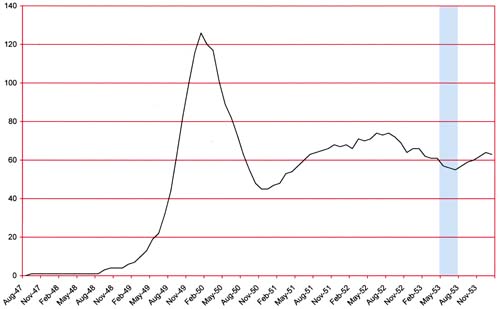
Number of Romance Titles 1947 – 1954 (the period covered in this chapter is shaded in blue)
The artists who contributed to the romance titles during this period were the same as those covered in the last chapter; Jack Kirby, Bill Draut, Mort Meskin, John Prentice and Al Eadeh. Kirby was by far the most prolific having penciled 97 pages of art. Second place went to Draut (41 pages), followed by Prentice (21 pages), Meskin (18 pages) and then Eadeh (12 pages). The only other artist involved only produced two single page features both in the same issue (YR #57) and was likely a studio assistant. Still missing were some other artists that not so long ago had been doing a share of the work; Bob McCarty(?), Bill Walton and George Roussos.
Over a period of about half a year there has been a dramatic shift in the amount of art produced by Mort Meskin and Jack Kirby. Prior to this shift Meskin was producing a lot of romance art while Kirby was doing much less. Now the rolls were reverse with Jack being quite productive and Mort doing relatively little work. I do not think this reversal was coincidental. It would appear that Kirby was doing the work that had previously been going to Meskin. It is not at all clear whether this was because Meskin for some reason could no longer produce the same amount of work or whether Simon and Kirby decided to give him much less work to do. There is no sign that Mort made up for this loss of work by doing more in the titles he appeared in that were not produced by Simon and Kirby (Headline, Justice Traps the Guilty and Prize Comics Western). Nor had Meskin at this time begun working for other comic book publishers. Whatever the explanation, Mort’s had suffered a rather drastic drop in income.

Young Romance #59 (July 1953) “A Family Affair”, pencils and inking by Jack Kirby
There were some significant format changes that fully developed during the period covered by this chapter. One of the most noticeable is the almost complete abandonment of full page splashes. The splash for “A Family Affair” is the only full page splash in any of the 8 issues. The move away from the larger splash was obviously not due to any flagging talent on Kirby’s part as this splash is full of Kirby punch (pun intended). I am not sure what the teen-age girl purchasers of the day felt about such action in a romance comic, but it sure makes a dramatic splash for a modern reader. Jack makes great use of the often awkward space left over from the inclusion of the single story panel. Kirby creates a powerful diagonal that starts at the lower left and ascends to the upper right corner. Almost all the parts of the composition takes part in that diagonal except for the female protagonist who balances out the story panel where she also appears.
The first story panel for “A Family Affair” is an example of another of the format changes that occurred during this period. It is not a true story panel but rather a confessional panel where the protagonists introduce the story. Previously we have seen the frequent use of what I have described as a confessional splash where a characters also introduces the story and where the speech balloon forms the title of the story. Confessional splashes still are used although perhaps not quite as commonly as before (there are four). I do not want to over emphasize the use of confessional story panels; there are only four features that use them.
Jack may have been producing a lot more art than he had for some time but this did not affect the quality of what art he did create. If anything his work is stronger then ever. I think this maybe due to Kirby doing a greater percentage of the inking then he has been. Certainly the spotting in the splash for “A Family Affair” looks like Kirby’s brushwork.
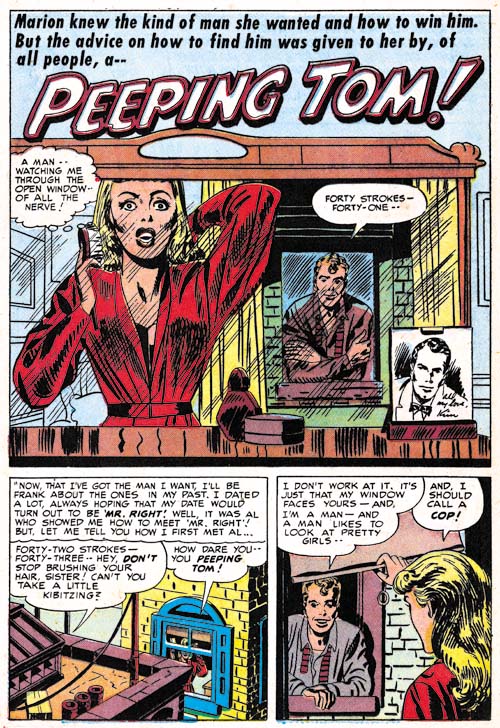
Young Romance #57 (May 1953) “Peeping Tom”, art by Jack Kirby
A more significant format change that became common during this period concerns the use of the splash panel. Previously Simon and Kirby productions, and in fact almost all comics by any publisher, used the splash as the comic book equivalent of the movie trailer. That is the splash would provide a sort of synopsis of the story to entice the reader. Now some of the Simon and Kirby productions would have a splash that was actually the first panel of the story. “Peeping Tom” is a good example. Carefully done, as in “Peeping Tom”, the splash still entices the reader but it is also an essential start to the story. Remove it and the following panels are difficult to understand.
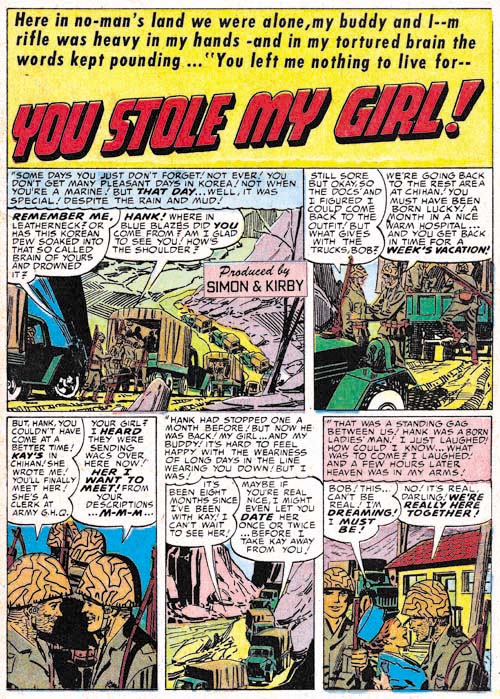
Young Romance #59 (July 1953) “You Stole My Girl”, art by Mort Meskin
Some stories have gone even further then making the splash into the first panel of the story, in them the splash panel is eliminated entirely. This would even be done in the first, or lead, story of a comic. The “produced by Simon and Kirby” cartouche would still appear but it would seem a bit oversized and out of place in the first panel.
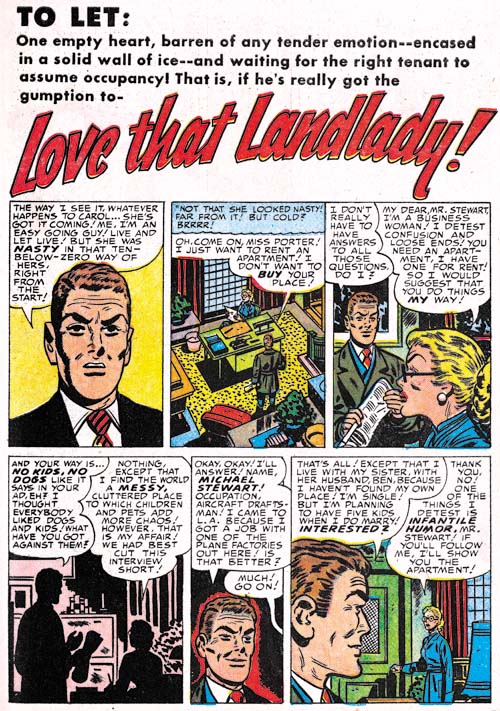 Young Romance #58 (June 1953) “Love That Landlady”, art by Bill Draut
Young Romance #58 (June 1953) “Love That Landlady”, art by Bill Draut
For some pieces two of the new story formats would be combined. In “Love That Landlady” the splash panel has been eliminated and the first panel provides a confessional by the male protagonists. Most of the confessional story panels were used in features without splashes.
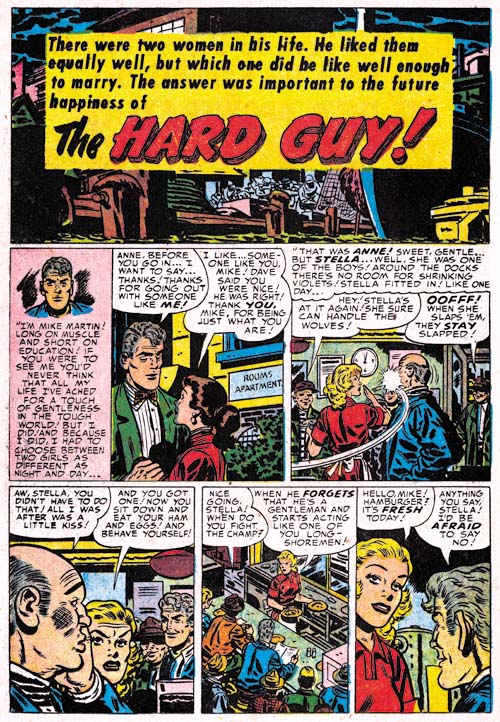
Young Love #46 (June 1953) “The Hard Guy”, art by Bill Draut
One consequence of using the splash as the first story panel or eliminating it entirely was that the title ended up isolated in a band at the top of the page. Frankly this resulted in a visually un-integrated and rather uninteresting title caption box. Only one artist appeared to address this deficiency and that was Bill Draut in “The Hard Guy”. The art work in the title caption would never be mistaken for a splash and it certainly was not the start of the story. All it provided was an ambiance of a run down waterfront to the title. Not much but in my opinion very effective. However none of the other artists seem to have picked up this approach and Draut did not repeat it, at least for the titles covered in this chapter.
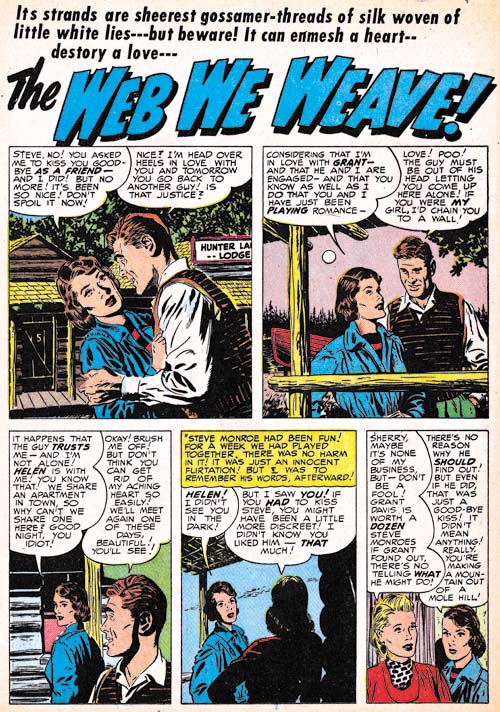
Young Love #47 (July 1953) “The Web We Weave”, art by John Prentice
Except for the unidentified artists of two single page features, all the artists did stories with the new formats. I provide above an example of a splashless story by John Prentice.

Young Brides #5 (May 1953) “Stepchild”, art by John Prentice
Not all the stories used the new formats; some were pretty much indistinguishable from those of earlier issues. I have a fondness for the borderless splashes that John Prentice occasionally uses and so I provide an image from “Stepchild”. Perhaps this is not the best example of an older format because the first story panel is a confessional introduction.

Young Romance #59 (July 1953) “Love Me, Don’t Laugh at Me”, art by Bill Draut
Simon and Kirby productions could still provide strong story lines. “Love Me, Don’t Laugh at Me” begins (in the splash) with an attempted suicide. Pretty strong stuff but of course the protagonist does not die in the end. In a way this is another example of confessional as the lady proceeds to tell her life story to explain how see arrived at such an emotional state.
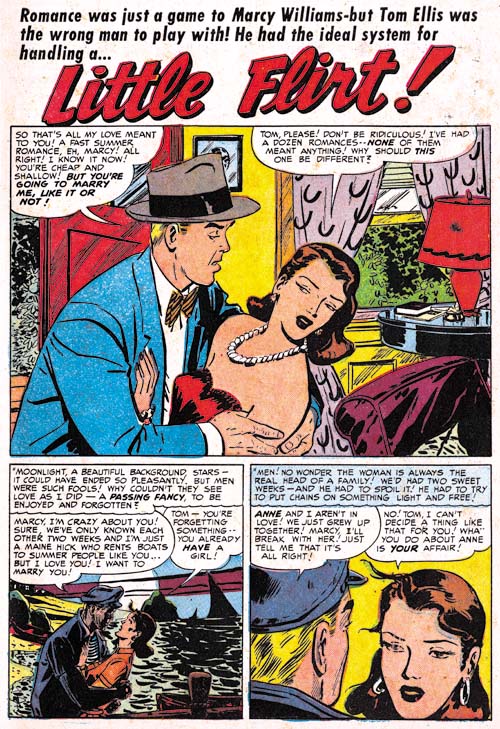
Young Romance #57 (May 1953) “Little Flirt”, art by Al Eadeh
Al Eadeh only did two stories for this period. I could have chosen “The Perfect Setup” as a further example of the use of the new formats (in this case without a splash) but “Little Flirt” is probably the best drawn romance story that Eadeh has provided Simon and Kirby. It is in a more standard format.
I have finally settled my mind about attributing these works to Al Eadeh. I had previously visited the Atlas Tales site but had then concentrated on the females because Eadeh does them in such a distinctive manner. Unfortunately there were few examples in Atlas Tales that provided examples of women. This time I returned but concentrated on the men. Sure enough there are some signed works that clearly were done by the same artist that was working for Simon and Kirby.
Splashes that are actually the start of the story, splashless stories and stories with confessional introductions are pretty recent and sudden developments. Actually Chapter 21 included “Loving is Believing” by Bob McCarty with a splash that was the beginning of the story. Not all stories used the new formats, actually there still were 13 standard and 4 confessional splash with 5 story splashes and 8 no splashes. While Kirby did 3 story splashes he did not do any features without a splash. If we remove Kirby from the statistics we get 4 standard splashes, 1 confessional splash, 2 story splashes and 8 no splashes. What was behind this shift? It could be just the use of a new script writer. However since Simon and Kirby always placed much importance on the splash I rather expect that this was a directive from one of them. Since Kirby did not participate in the new format as much as the other artists I suspect therefore this was largely Simon’s doing.
Chapter 1, A New Genre (YR #1 – #4)
Chapter 2, Early Artists (YR #1 – #4)
Chapter 3, The Field No Longer Their’s Alone (YR #5 – #8)
Chapter 4, An Explosion of Romance (YR #9 – #12, YL #1 – #4)
Chapter 5, New Talent (YR #9 – 12, YL #1 – #4)
Chapter 6, Love on the Range (RWR #1 – #7, WL #1 – #6)
Chapter 7, More Love on the Range (RWR #1 – #7, WL #1 – #6)
Chapter 8, Kirby on the Range? (RWR #1 – #7, WL #1 – #6)
Chapter 9, More Romance (YR #13 – #16, YL #5 – #6)
Chapter 10, The Peak of the Love Glut (YR #17 – #20, YL #7 – #8)
Chapter 11, After the Glut (YR #21 – #23, YL #9 – #10)
Chapter 12, A Smaller Studio (YR #24 – #26, YL #12 – #14)
Chapter 13, Romance Bottoms Out (YR #27 – #29, YL #15 – #17)
Chapter 14, The Third Suspect (YR #30 – #32, YL #18 – #20)
Chapter 15, The Action of Romance (YR #33 – #35, YL #21 – #23)
Chapter 16, Someone Old and Someone New (YR #36 – #38, YL #24 – #26)
Chapter 17, The Assistant (YR #39 – #41, YL #27 – #29)
Chapter 18, Meskin Takes Over (YR #42 – #44, YL #30 – #32)
Chapter 19, More Artists (YR #45 – #47, YL #33 – #35)
Chapter 20, Romance Still Matters (YR #48 – #50, YL #36 – #38, YB #1)
Chapter 21, Roussos Messes Up (YR #51 – #53, YL #39 – #41, YB #2 – 3)
Chapter 22, He’s the Man (YR #54 – #56, YL #42 – #44, YB #4)
Chapter 23, New Ways of Doing Things (YR #57 – #59, YL #45 – #47, YB #5 – #6)
Chapter 24, A New Artist (YR #60 – #62, YL #48 – #50, YB #7 – #8)
Chapter 25, More New Faces (YR #63 – #65, YLe #51 – #53, YB #9 – #11)
Chapter 26, Goodbye Jack (YR #66 – #68, YL #54 – #56, YB #12 – #14)
Chapter 27, The Return of Mort (YR #69 – #71, YL #57 – #59, YB #15 – #17)
Chapter 28, A Glut of Artists (YR #72 – #74, YL #60 – #62, YB #18 & #19, IL #1 & #2)
Chapter 29, Trouble Begins (YR #75 – #77, YL #63 – #65, YB #20 – #22, IL #3 – #5)
Chapter 30, Transition (YR #78 – #80, YL #66 – #68, YBs #23 – #25, IL #6, ILY #7)
Chapter 30, Appendix (YB #23)
Chapter 31, Kirby, Kirby and More Kirby (YR #81 – #82, YL #69 – #70, YB #26 – #27)
Chapter 32, The Kirby Beat Goes On (YR #83 – #84, YL #71 – #72, YB #28 – #29)
Chapter 33, End of an Era (YR #85 – #87, YL #73, YB #30, AFL #1)
Chapter 34, A New Prize Title (YR #88 – #91, AFL #2 – #5, PL #1 – #2)
Chapter 35, Settling In ( YR #92 – #94, AFL #6 – #8, PL #3 – #5)
Appendix, J.O. Is Joe Orlando
Chapter 36, More Kirby (YR #95 – #97, AFL #9 – #11, PL #6 – #8)
Chapter 37, Some Surprises (YR #98 – #100, AFL #12 – #14, PL #9 – #11)
Chapter 38, All Things Must End (YR #101 – #103, AFL #15 – #17, PL #12 – #14)


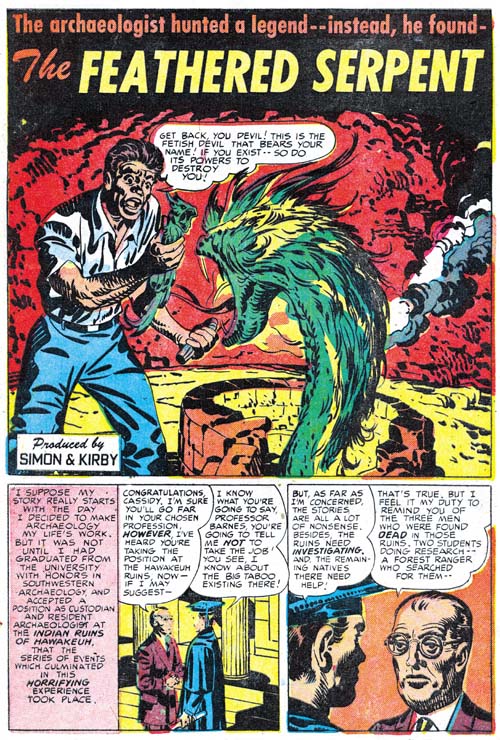
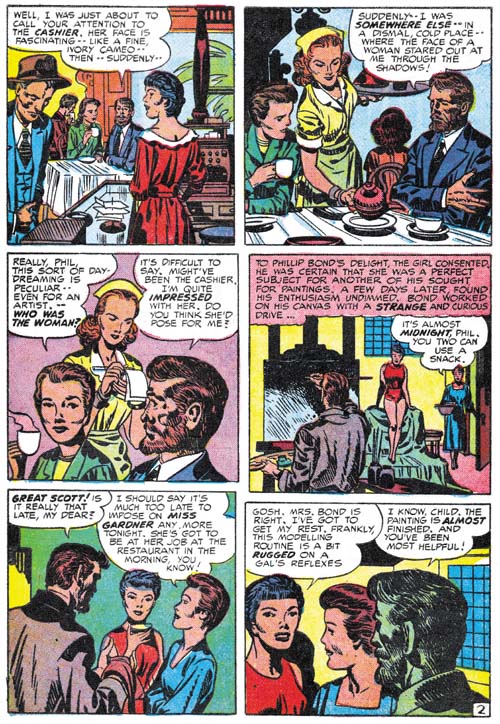
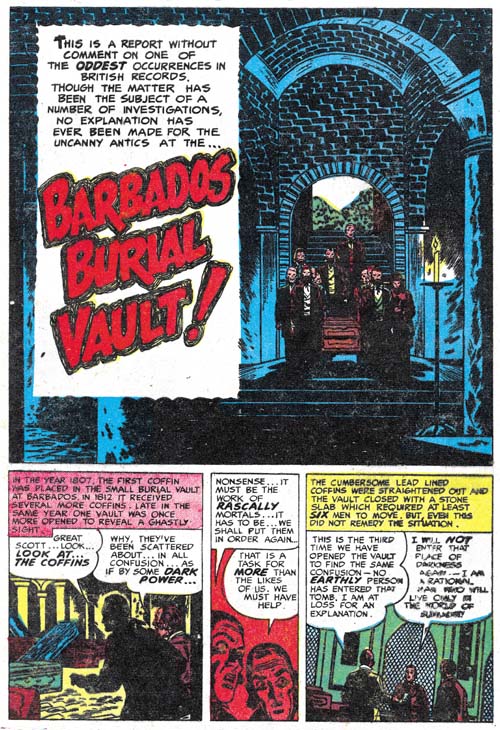
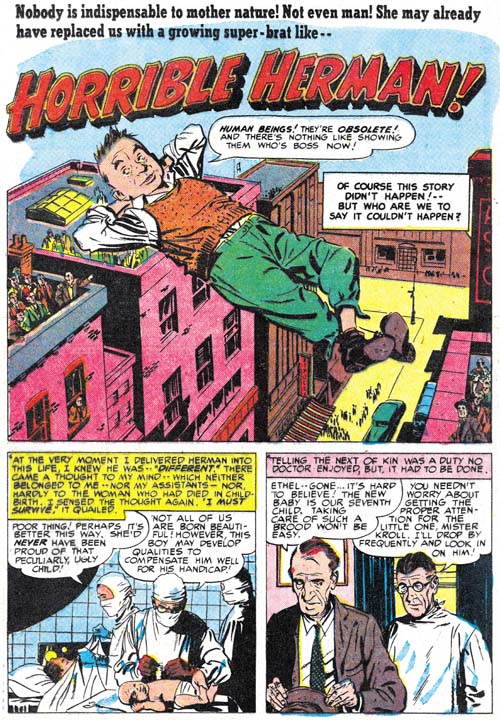
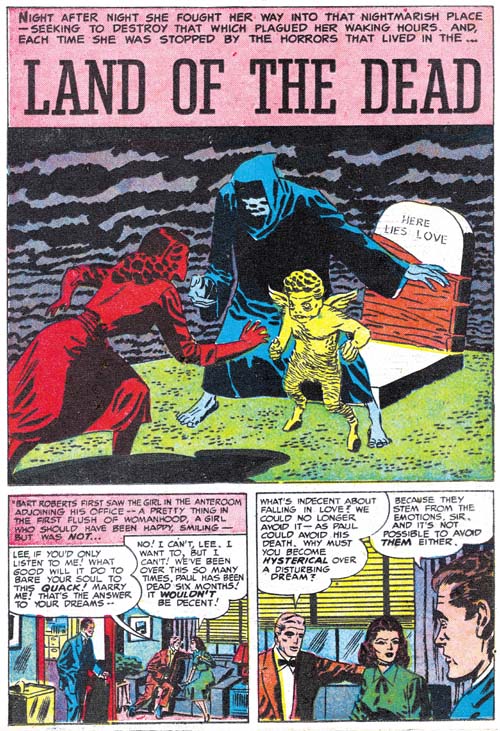
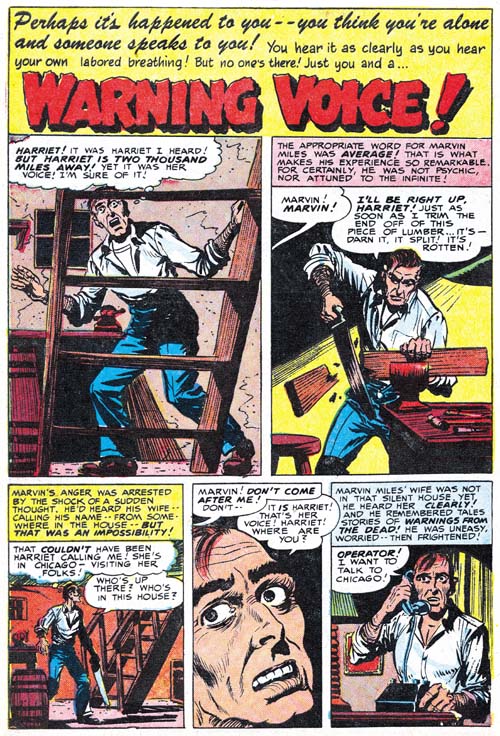
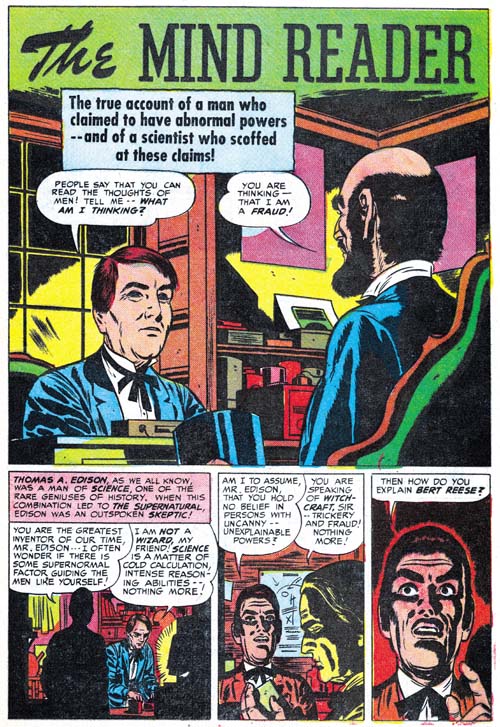
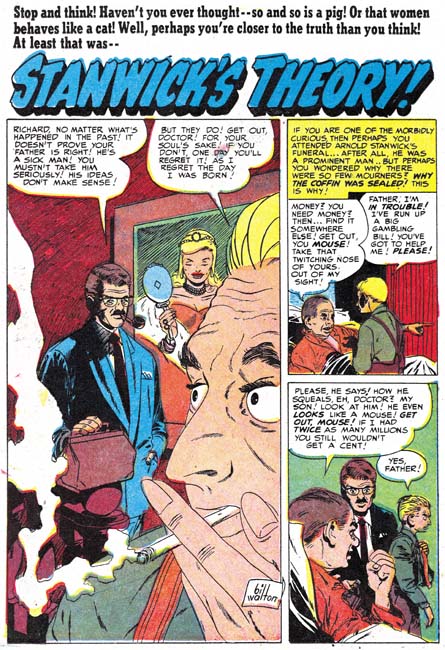
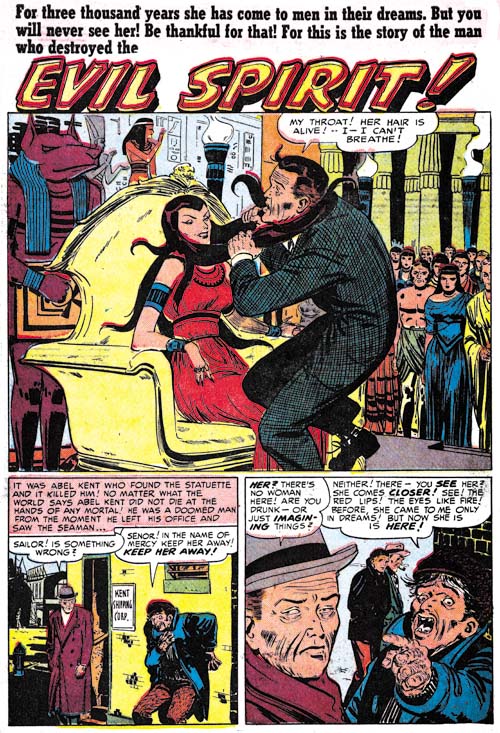

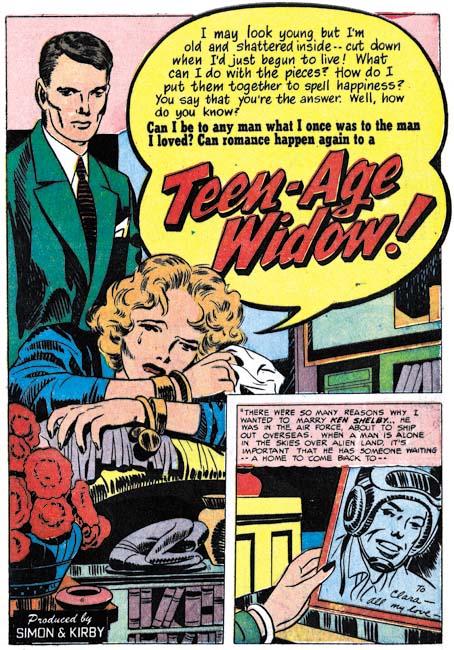
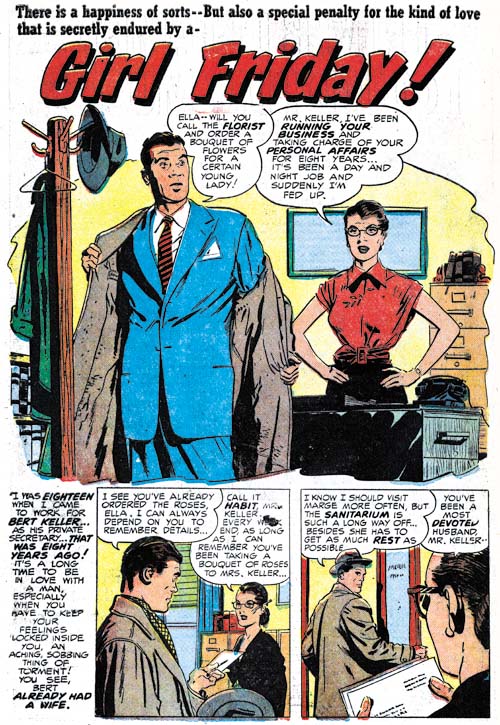
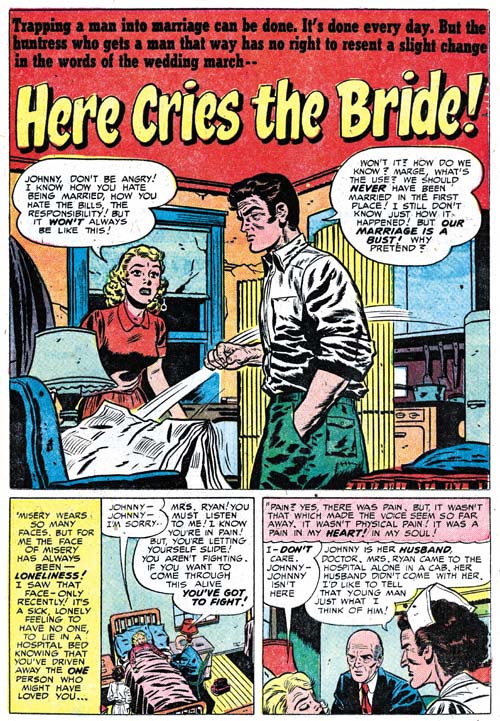
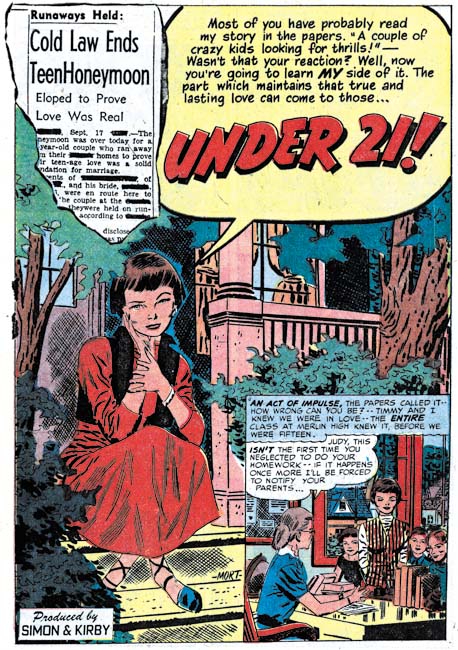
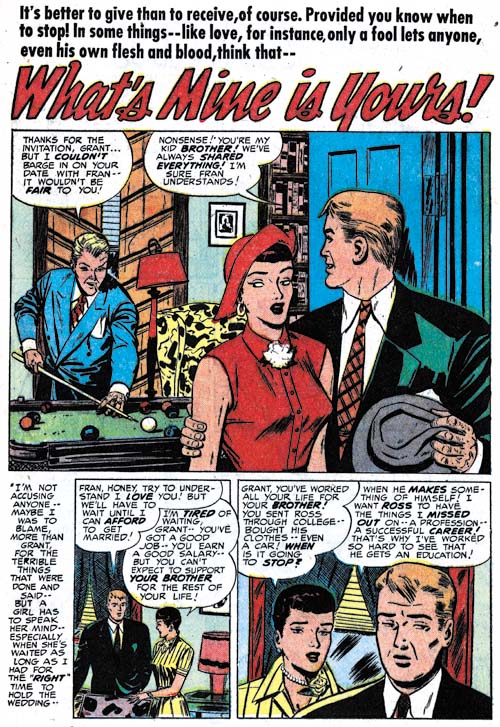
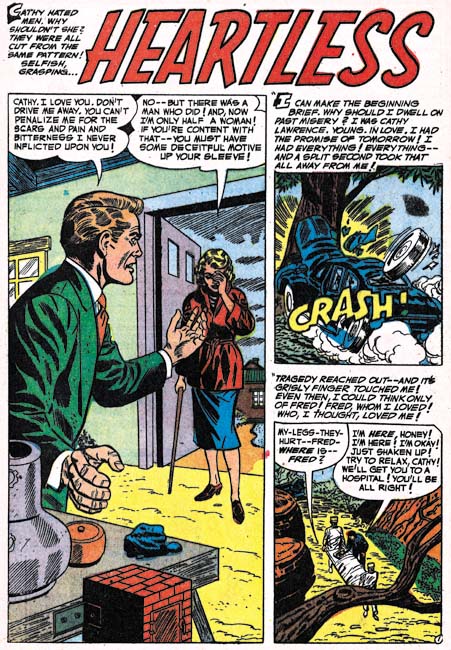
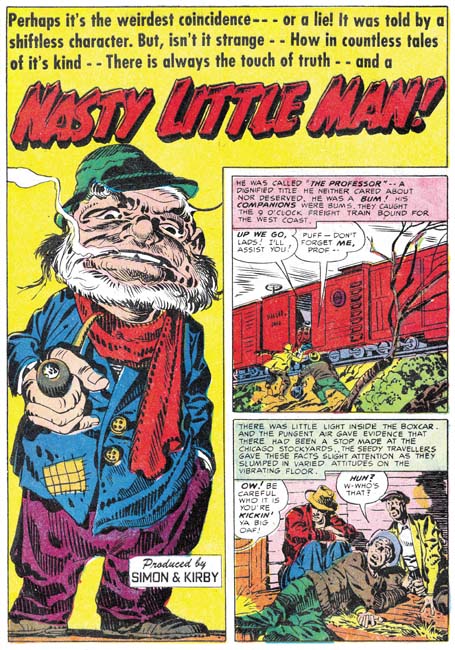
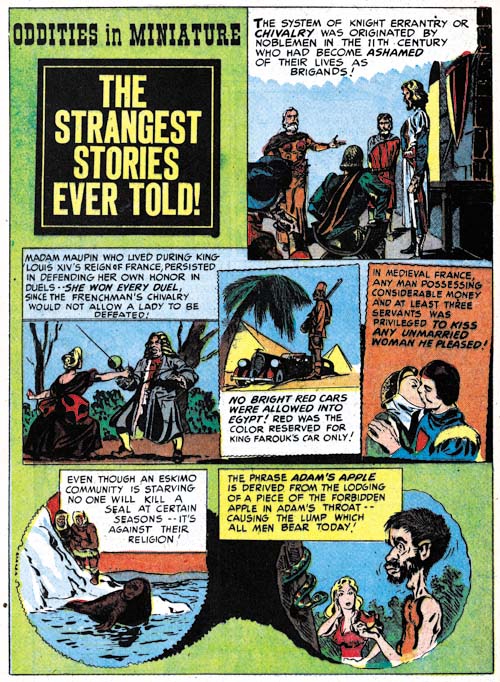
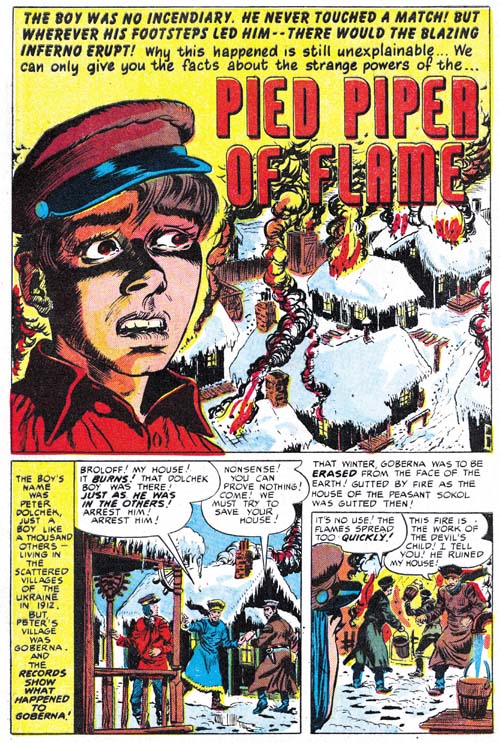
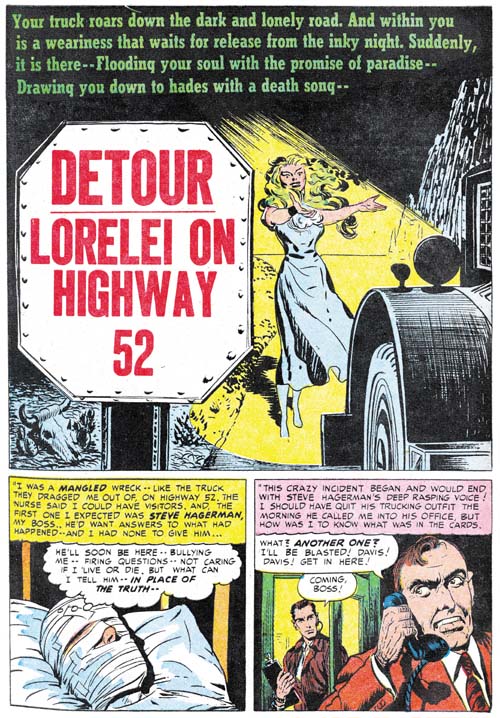
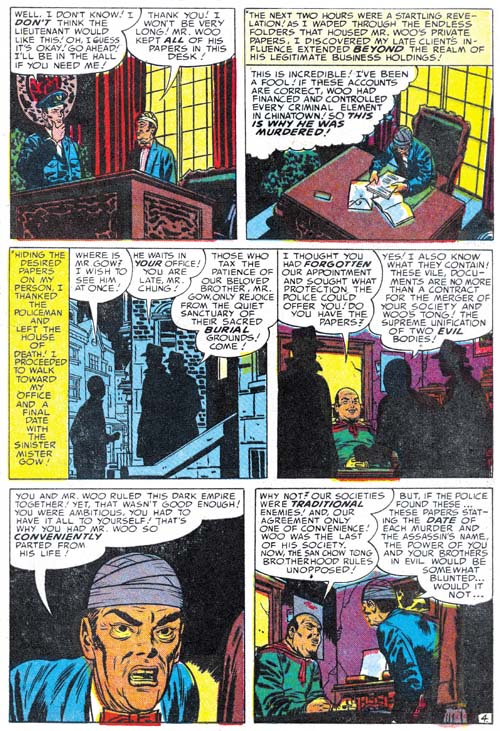
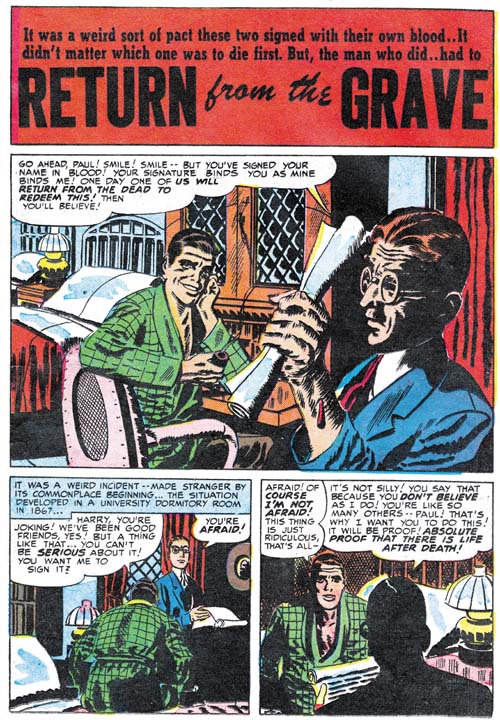
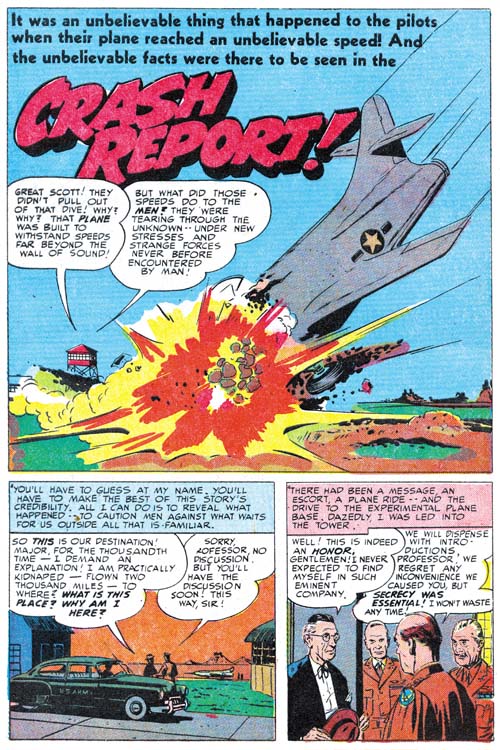
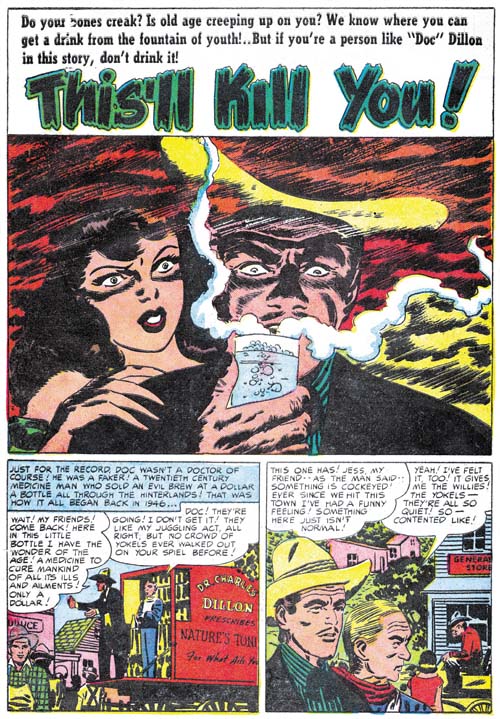
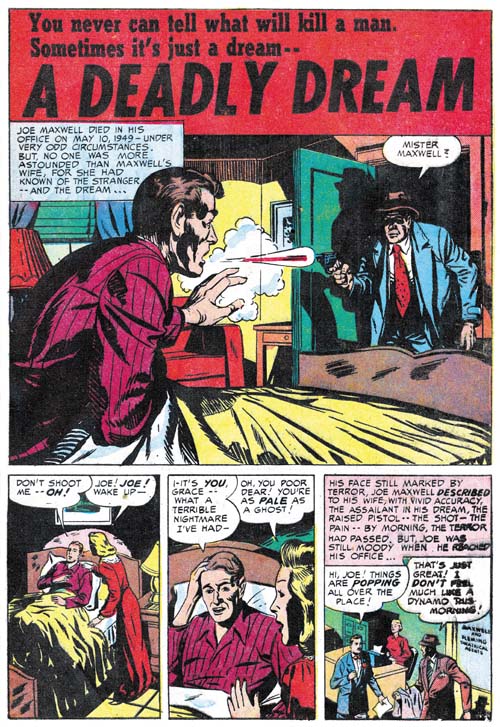

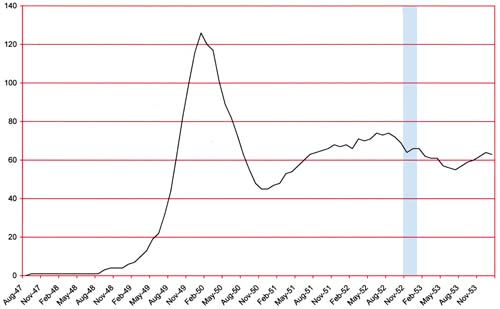
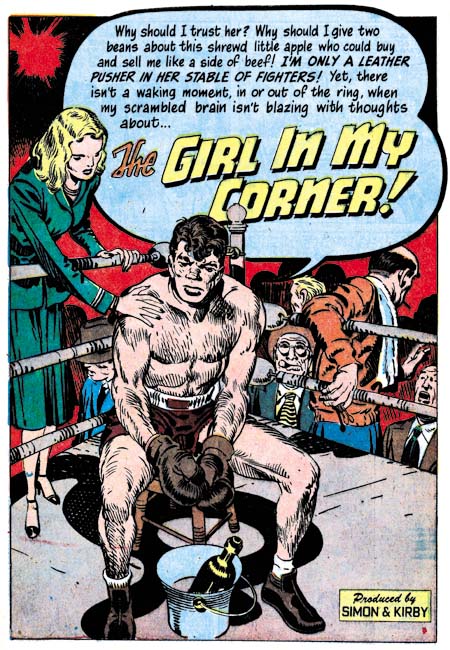
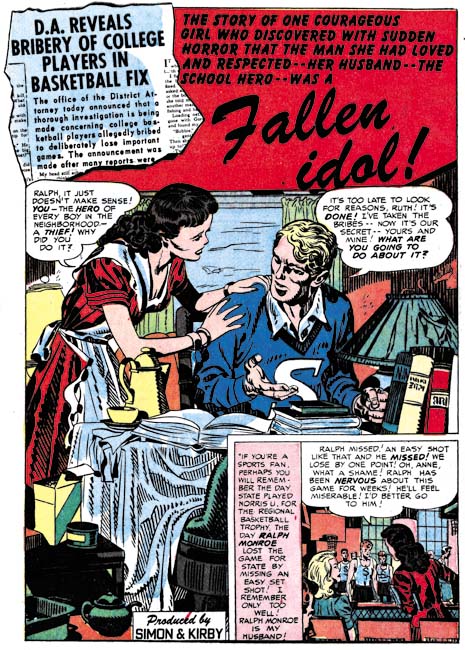
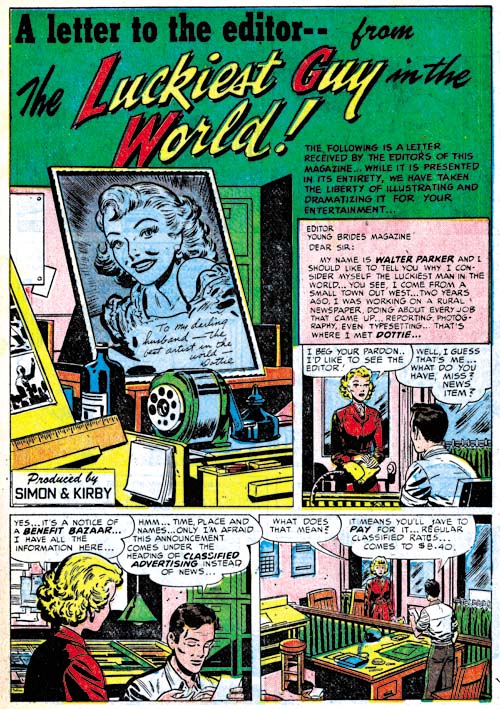
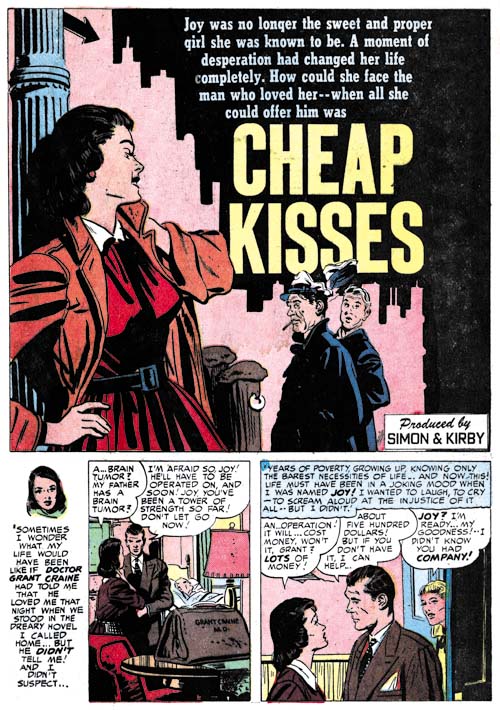
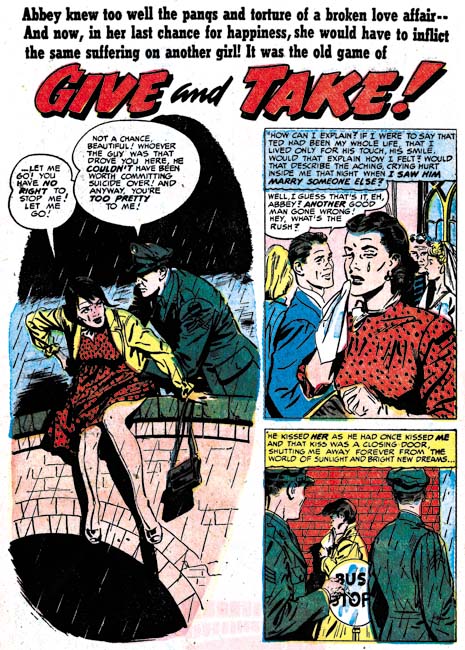
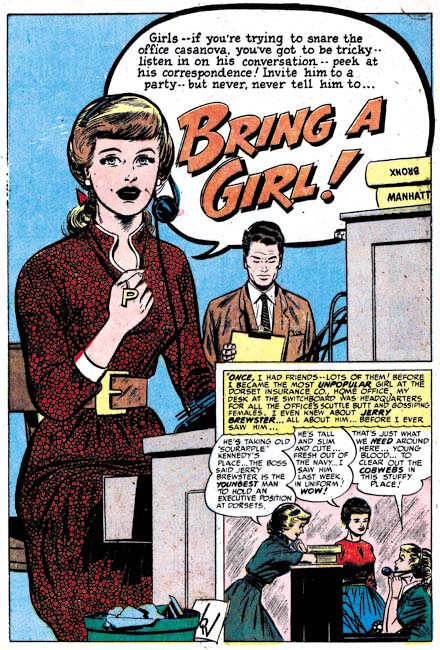
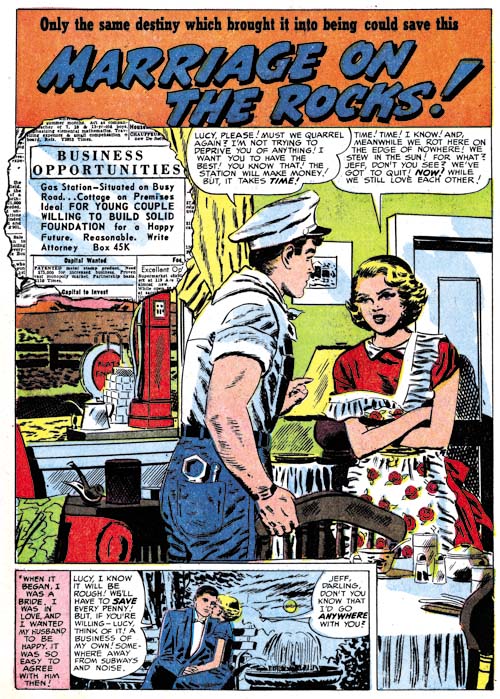


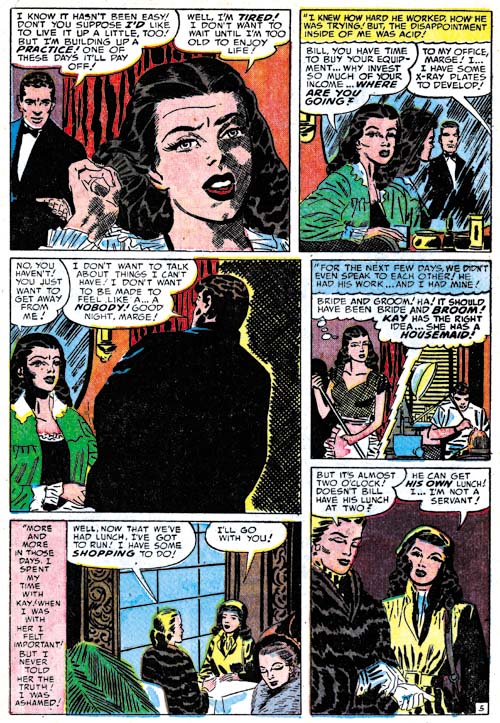
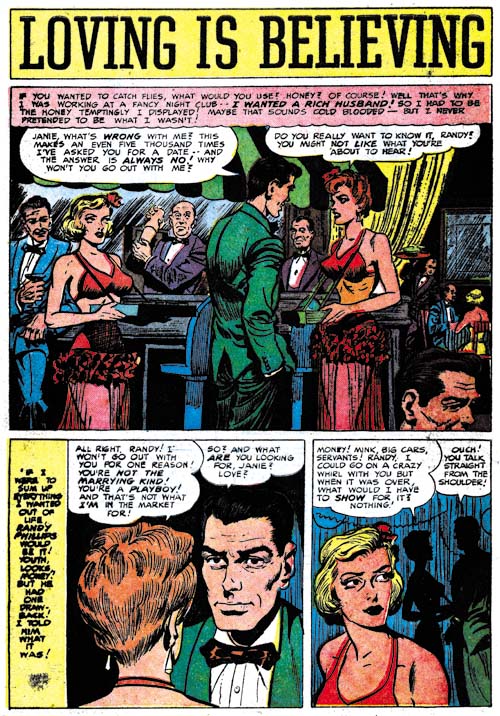
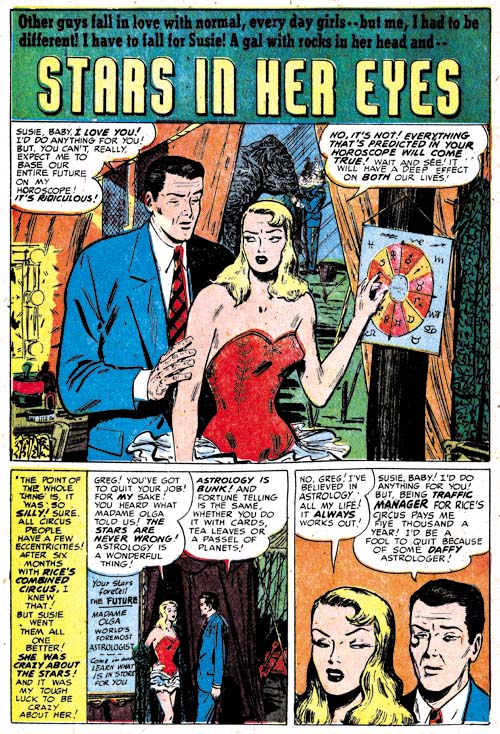


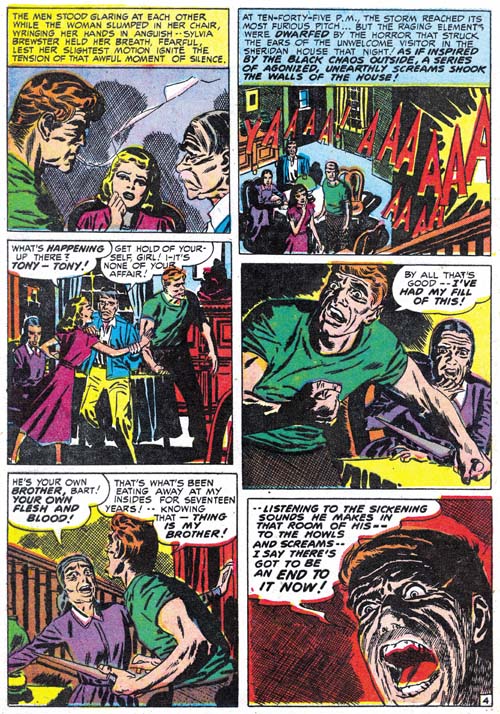
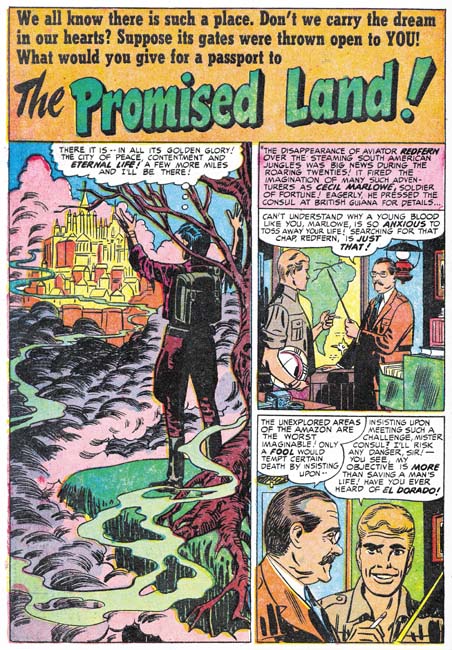
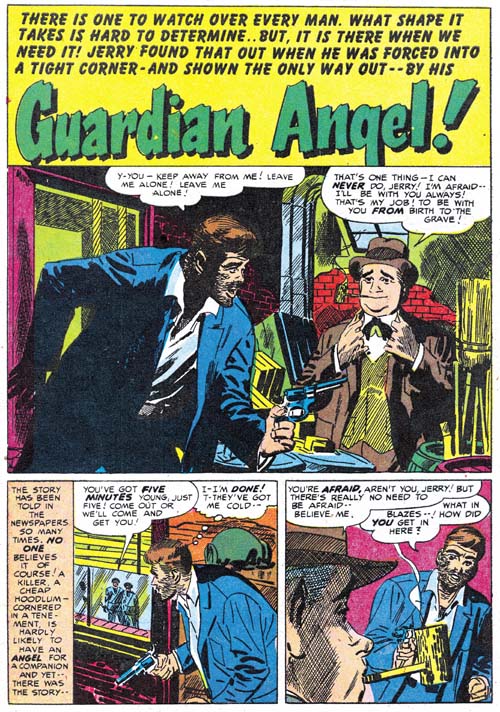
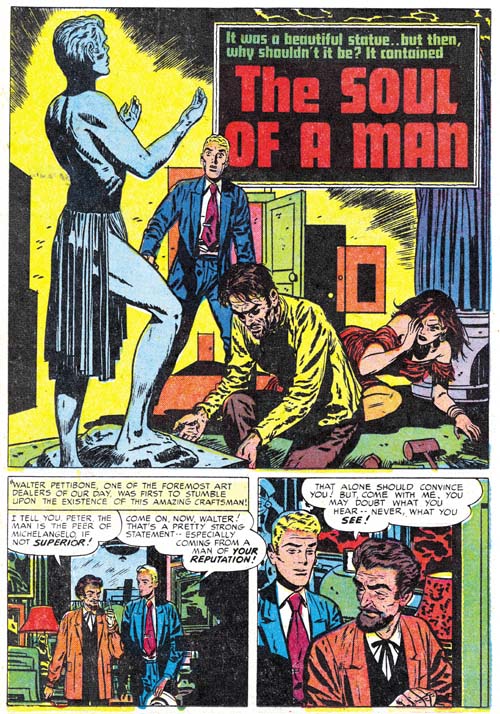
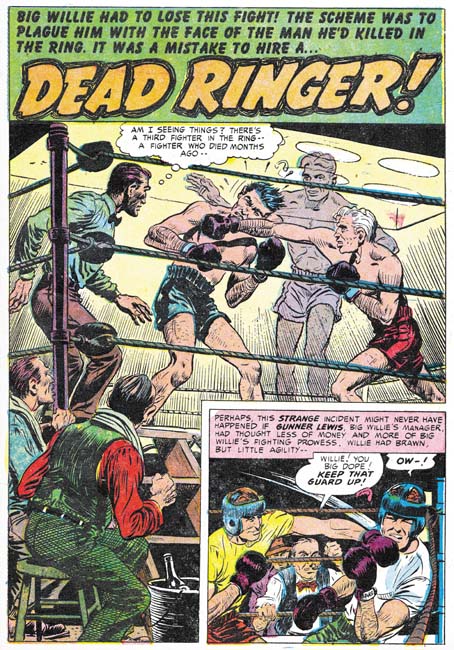
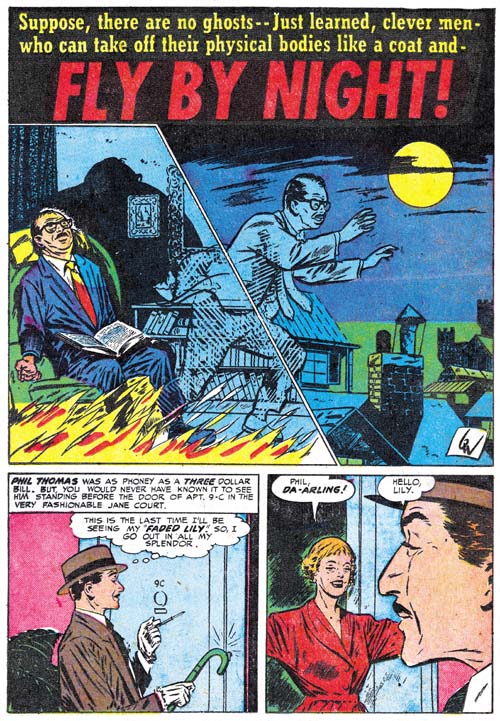
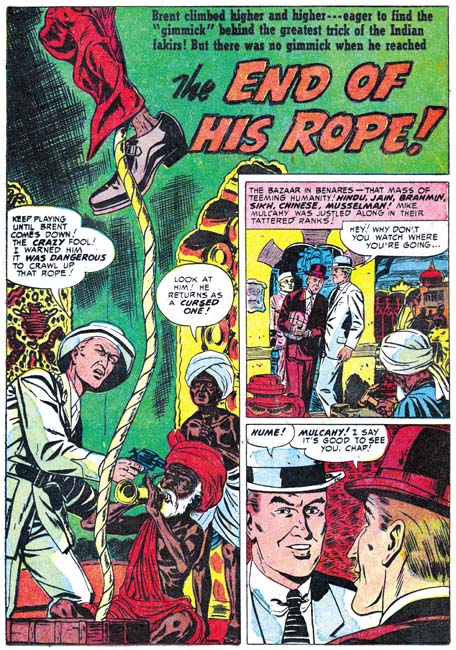
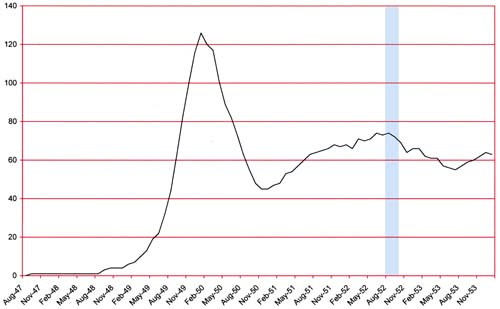
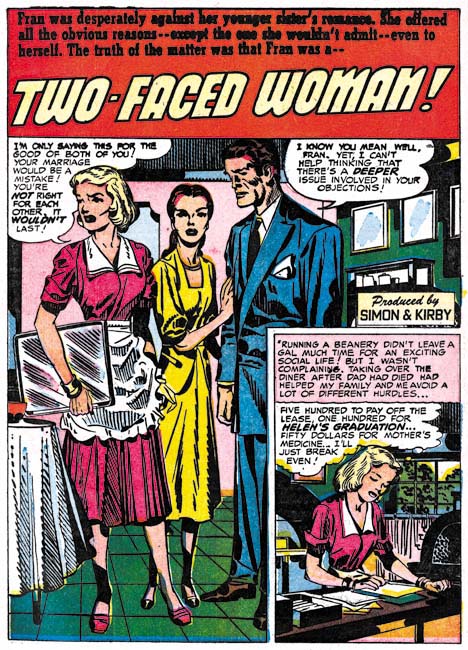
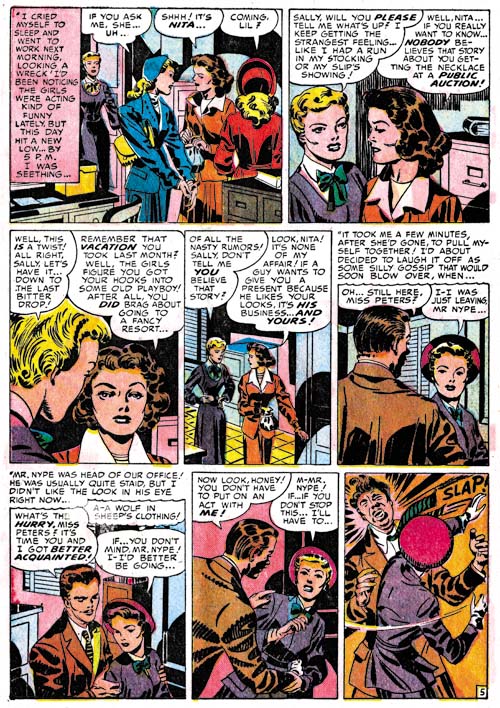
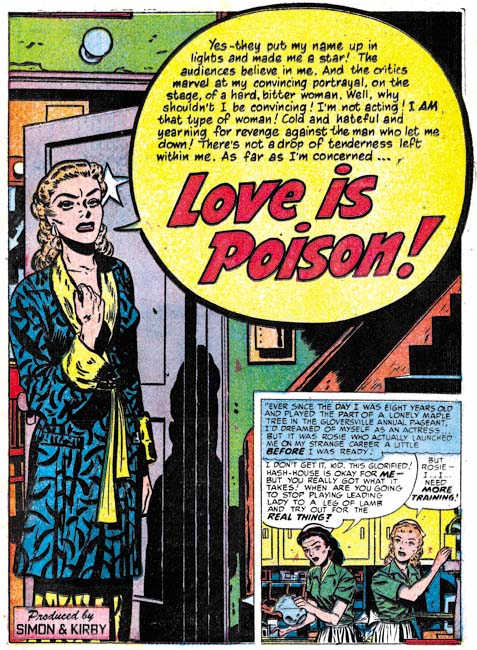
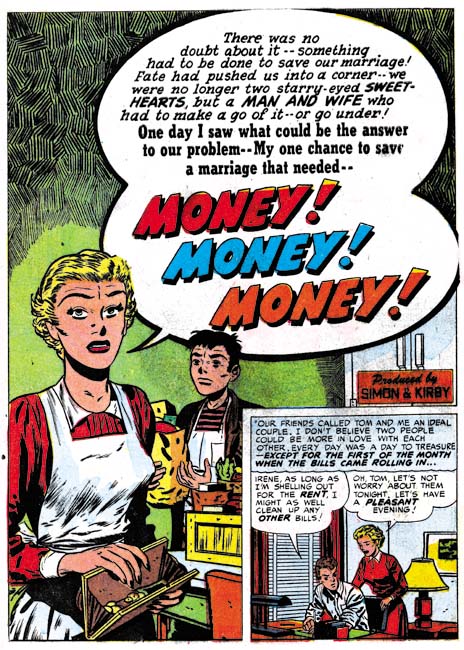

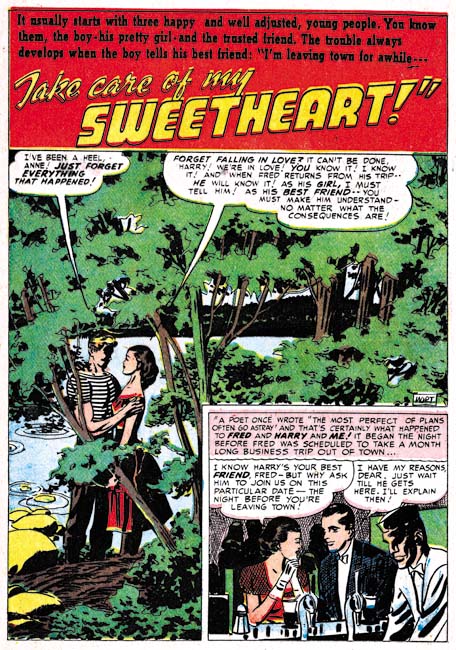
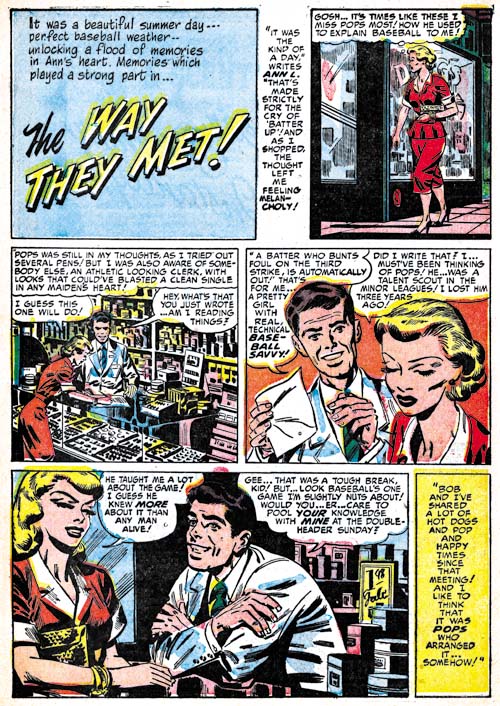
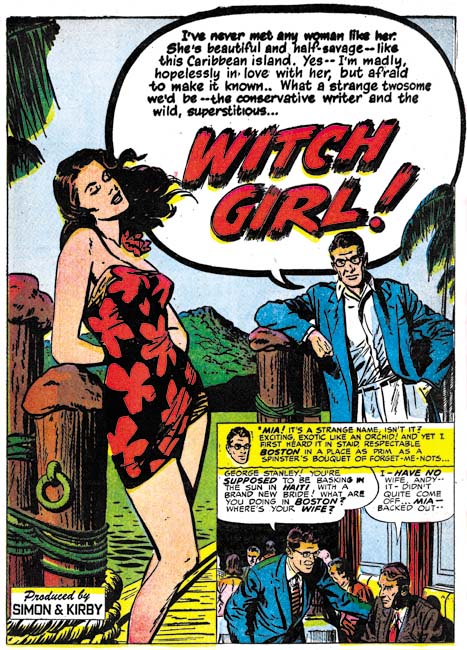


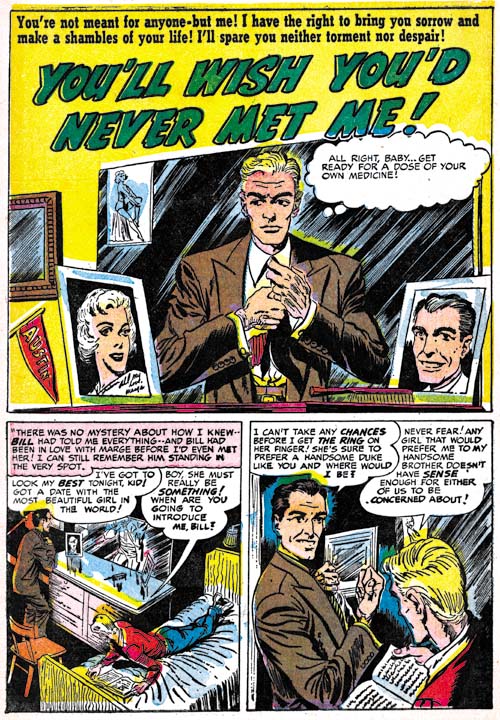
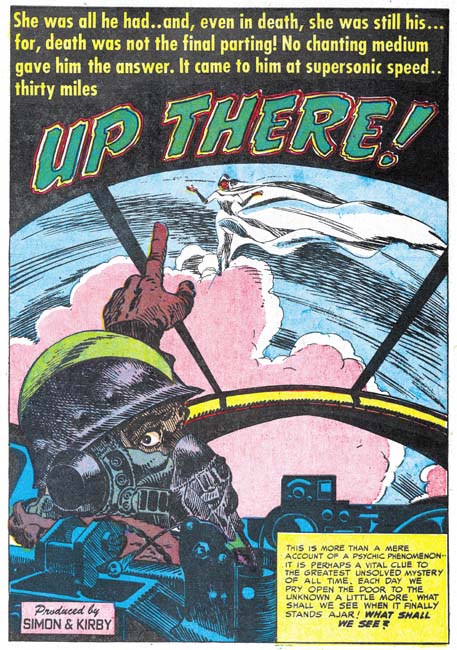

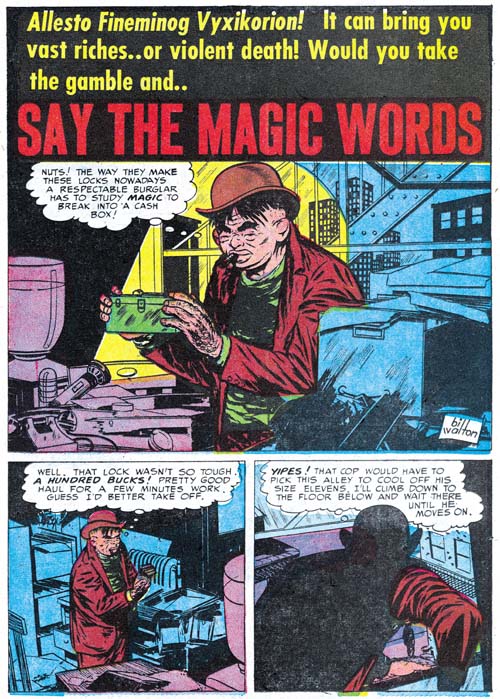
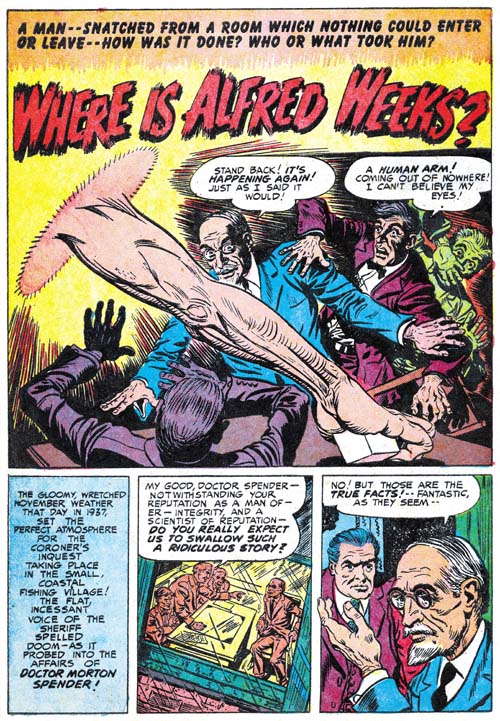

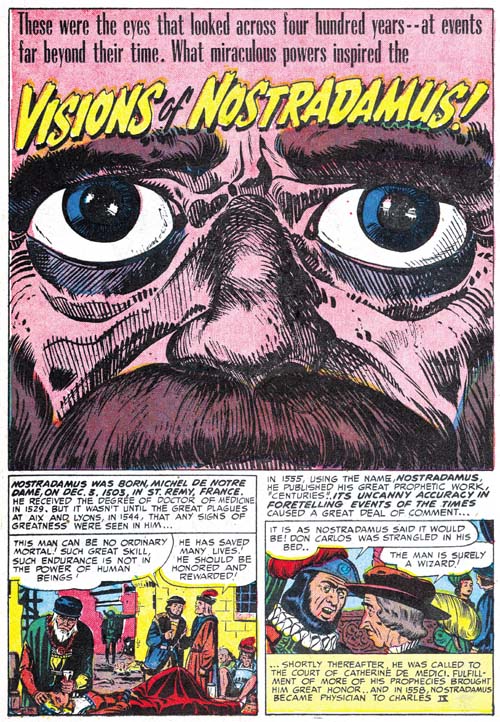
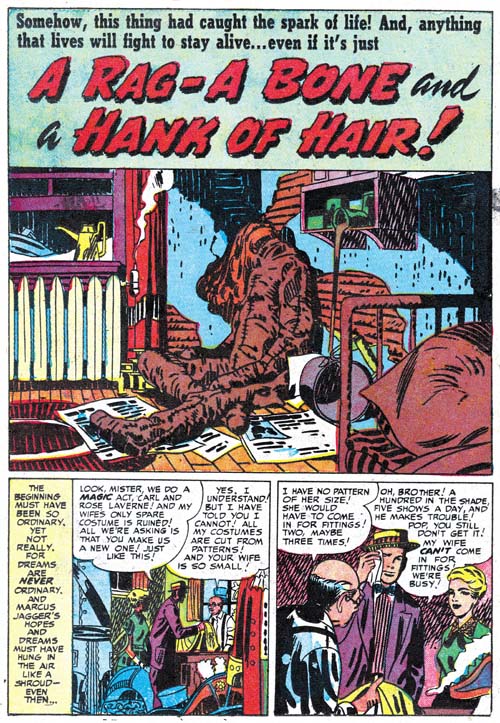

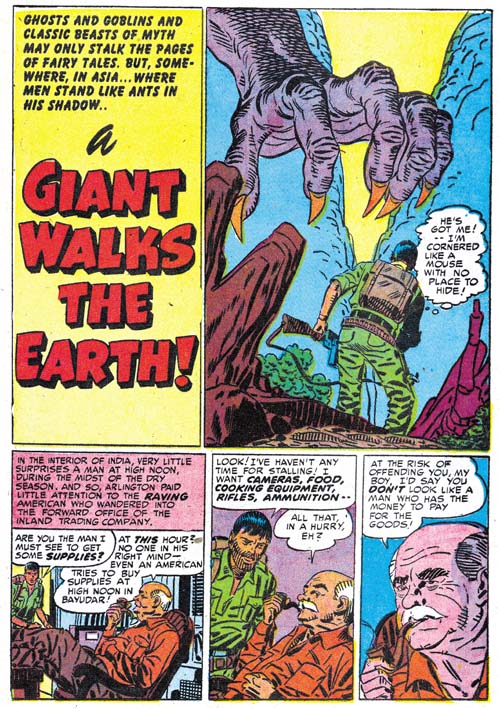

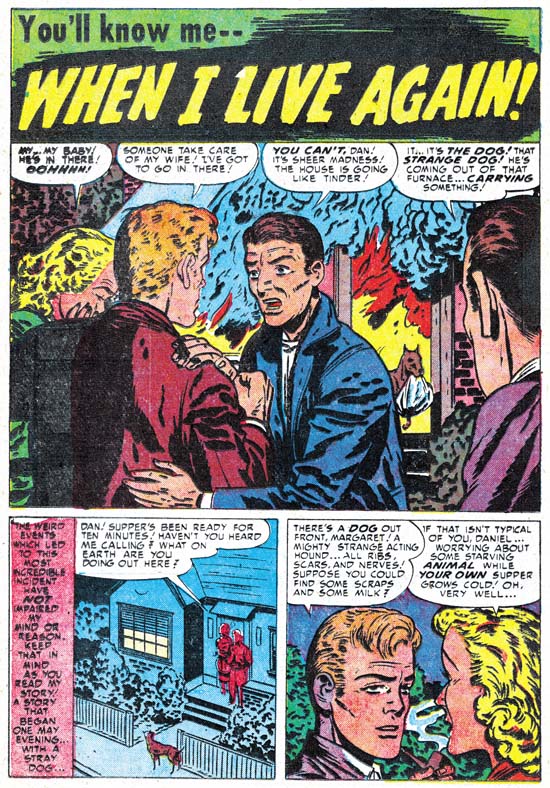
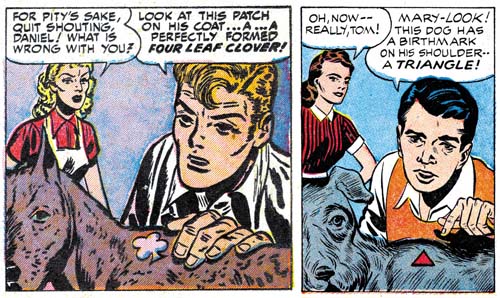
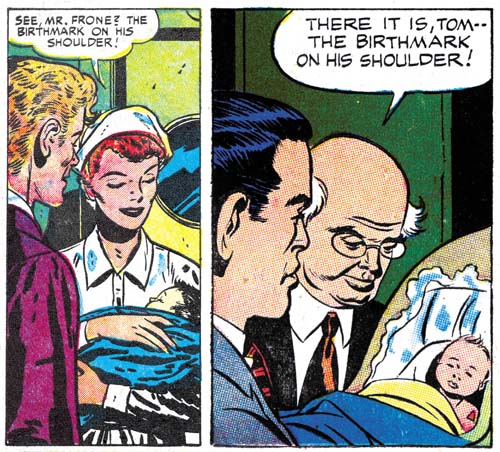
 Number of Romance Titles 1947 – 1953 (the period covered in this chapter is shaded in blue)
Number of Romance Titles 1947 – 1953 (the period covered in this chapter is shaded in blue)